Business Administration Report: Market, Innovation, and Finance
VerifiedAdded on 2020/10/05
|9
|2178
|119
Report
AI Summary
This report provides a comprehensive overview of key aspects of business administration. It begins with an introduction to business markets, exploring different types and the nature of interactions between businesses. The report then delves into business innovation, discussing models, sources of support, and the product or service development process, including benefits, risks, and implications. Financial viability is examined, including its importance, the consequences of poor financial management, and different financial terminologies. The report also covers budgeting, marketing principles, the sales process, market research, and branding. The report concludes with a discussion on the relationship between sales and marketing. The report is well-structured and includes references to support the analysis.
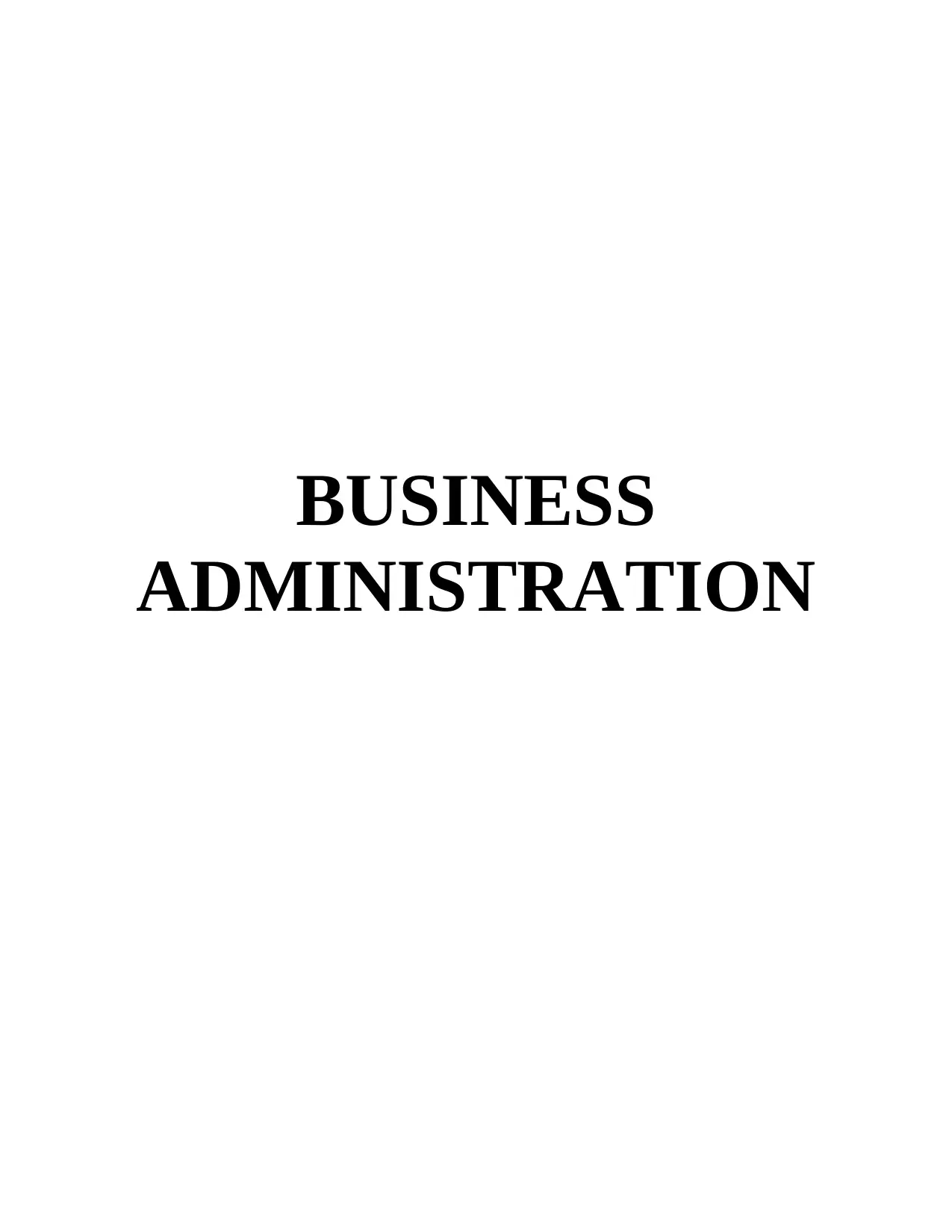
BUSINESS
ADMINISTRATION
ADMINISTRATION
Paraphrase This Document
Need a fresh take? Get an instant paraphrase of this document with our AI Paraphraser
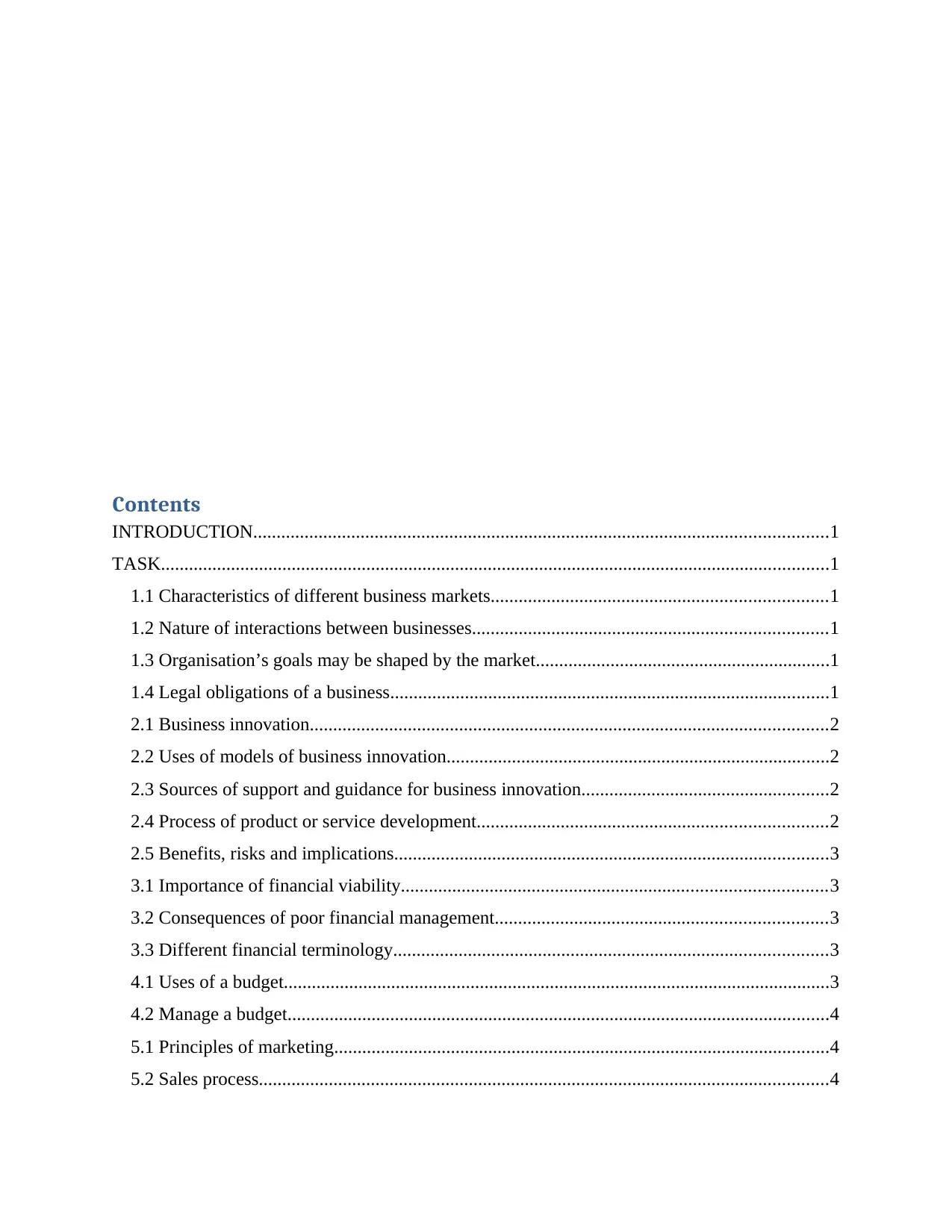
Contents
INTRODUCTION...........................................................................................................................1
TASK...............................................................................................................................................1
1.1 Characteristics of different business markets........................................................................1
1.2 Nature of interactions between businesses............................................................................1
1.3 Organisation’s goals may be shaped by the market...............................................................1
1.4 Legal obligations of a business..............................................................................................1
2.1 Business innovation...............................................................................................................2
2.2 Uses of models of business innovation..................................................................................2
2.3 Sources of support and guidance for business innovation.....................................................2
2.4 Process of product or service development...........................................................................2
2.5 Benefits, risks and implications.............................................................................................3
3.1 Importance of financial viability...........................................................................................3
3.2 Consequences of poor financial management.......................................................................3
3.3 Different financial terminology.............................................................................................3
4.1 Uses of a budget.....................................................................................................................3
4.2 Manage a budget....................................................................................................................4
5.1 Principles of marketing..........................................................................................................4
5.2 Sales process..........................................................................................................................4
INTRODUCTION...........................................................................................................................1
TASK...............................................................................................................................................1
1.1 Characteristics of different business markets........................................................................1
1.2 Nature of interactions between businesses............................................................................1
1.3 Organisation’s goals may be shaped by the market...............................................................1
1.4 Legal obligations of a business..............................................................................................1
2.1 Business innovation...............................................................................................................2
2.2 Uses of models of business innovation..................................................................................2
2.3 Sources of support and guidance for business innovation.....................................................2
2.4 Process of product or service development...........................................................................2
2.5 Benefits, risks and implications.............................................................................................3
3.1 Importance of financial viability...........................................................................................3
3.2 Consequences of poor financial management.......................................................................3
3.3 Different financial terminology.............................................................................................3
4.1 Uses of a budget.....................................................................................................................3
4.2 Manage a budget....................................................................................................................4
5.1 Principles of marketing..........................................................................................................4
5.2 Sales process..........................................................................................................................4

5.3 Features and uses of market research....................................................................................4
5.4 Value of a brand.....................................................................................................................5
5.5 Relationship between sales and marketing............................................................................5
CONCLUSION................................................................................................................................5
REFERENCES................................................................................................................................6
5.4 Value of a brand.....................................................................................................................5
5.5 Relationship between sales and marketing............................................................................5
CONCLUSION................................................................................................................................5
REFERENCES................................................................................................................................6
⊘ This is a preview!⊘
Do you want full access?
Subscribe today to unlock all pages.

Trusted by 1+ million students worldwide
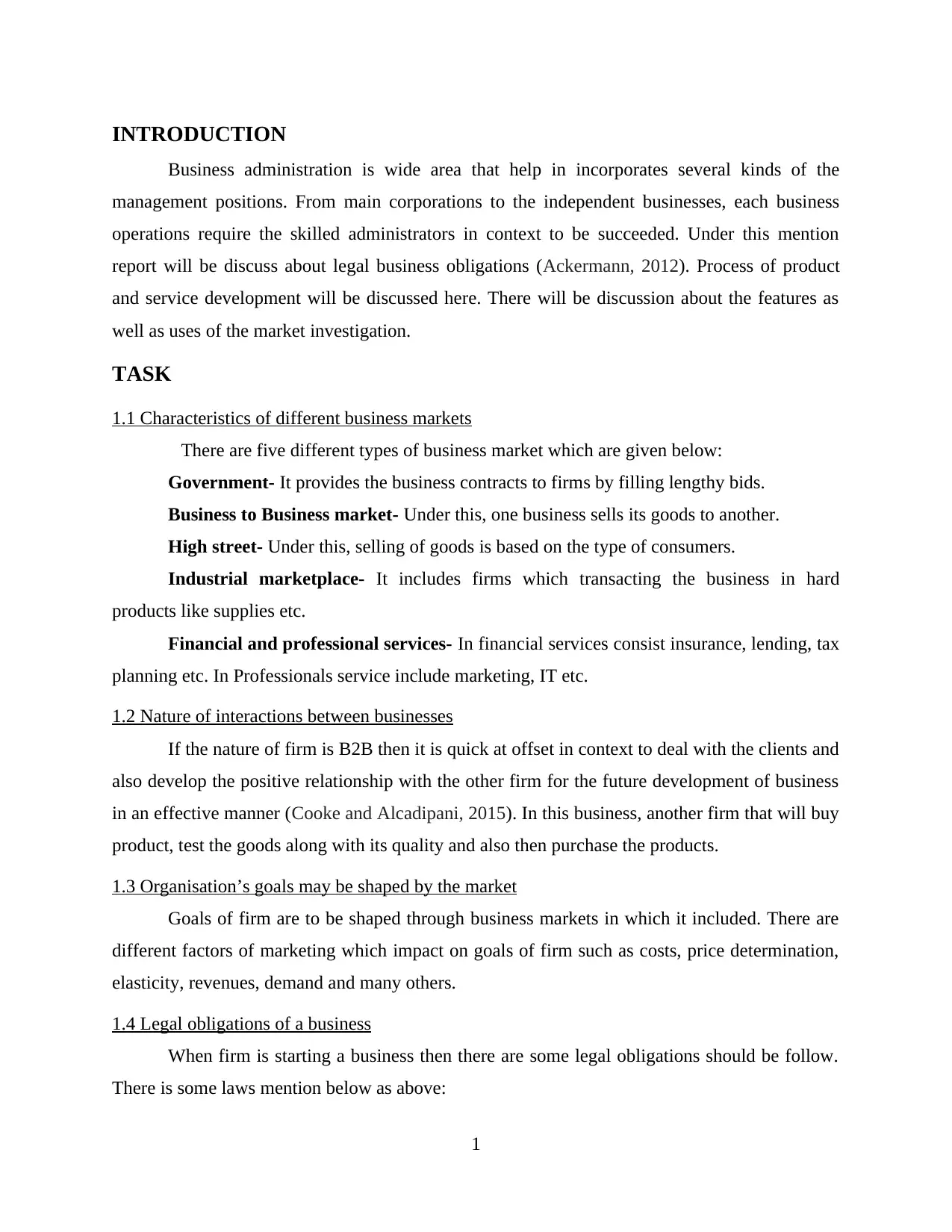
INTRODUCTION
Business administration is wide area that help in incorporates several kinds of the
management positions. From main corporations to the independent businesses, each business
operations require the skilled administrators in context to be succeeded. Under this mention
report will be discuss about legal business obligations (Ackermann, 2012). Process of product
and service development will be discussed here. There will be discussion about the features as
well as uses of the market investigation.
TASK
1.1 Characteristics of different business markets
There are five different types of business market which are given below:
Government- It provides the business contracts to firms by filling lengthy bids.
Business to Business market- Under this, one business sells its goods to another.
High street- Under this, selling of goods is based on the type of consumers.
Industrial marketplace- It includes firms which transacting the business in hard
products like supplies etc.
Financial and professional services- In financial services consist insurance, lending, tax
planning etc. In Professionals service include marketing, IT etc.
1.2 Nature of interactions between businesses
If the nature of firm is B2B then it is quick at offset in context to deal with the clients and
also develop the positive relationship with the other firm for the future development of business
in an effective manner (Cooke and Alcadipani, 2015). In this business, another firm that will buy
product, test the goods along with its quality and also then purchase the products.
1.3 Organisation’s goals may be shaped by the market
Goals of firm are to be shaped through business markets in which it included. There are
different factors of marketing which impact on goals of firm such as costs, price determination,
elasticity, revenues, demand and many others.
1.4 Legal obligations of a business
When firm is starting a business then there are some legal obligations should be follow.
There is some laws mention below as above:
1
Business administration is wide area that help in incorporates several kinds of the
management positions. From main corporations to the independent businesses, each business
operations require the skilled administrators in context to be succeeded. Under this mention
report will be discuss about legal business obligations (Ackermann, 2012). Process of product
and service development will be discussed here. There will be discussion about the features as
well as uses of the market investigation.
TASK
1.1 Characteristics of different business markets
There are five different types of business market which are given below:
Government- It provides the business contracts to firms by filling lengthy bids.
Business to Business market- Under this, one business sells its goods to another.
High street- Under this, selling of goods is based on the type of consumers.
Industrial marketplace- It includes firms which transacting the business in hard
products like supplies etc.
Financial and professional services- In financial services consist insurance, lending, tax
planning etc. In Professionals service include marketing, IT etc.
1.2 Nature of interactions between businesses
If the nature of firm is B2B then it is quick at offset in context to deal with the clients and
also develop the positive relationship with the other firm for the future development of business
in an effective manner (Cooke and Alcadipani, 2015). In this business, another firm that will buy
product, test the goods along with its quality and also then purchase the products.
1.3 Organisation’s goals may be shaped by the market
Goals of firm are to be shaped through business markets in which it included. There are
different factors of marketing which impact on goals of firm such as costs, price determination,
elasticity, revenues, demand and many others.
1.4 Legal obligations of a business
When firm is starting a business then there are some legal obligations should be follow.
There is some laws mention below as above:
1
Paraphrase This Document
Need a fresh take? Get an instant paraphrase of this document with our AI Paraphraser
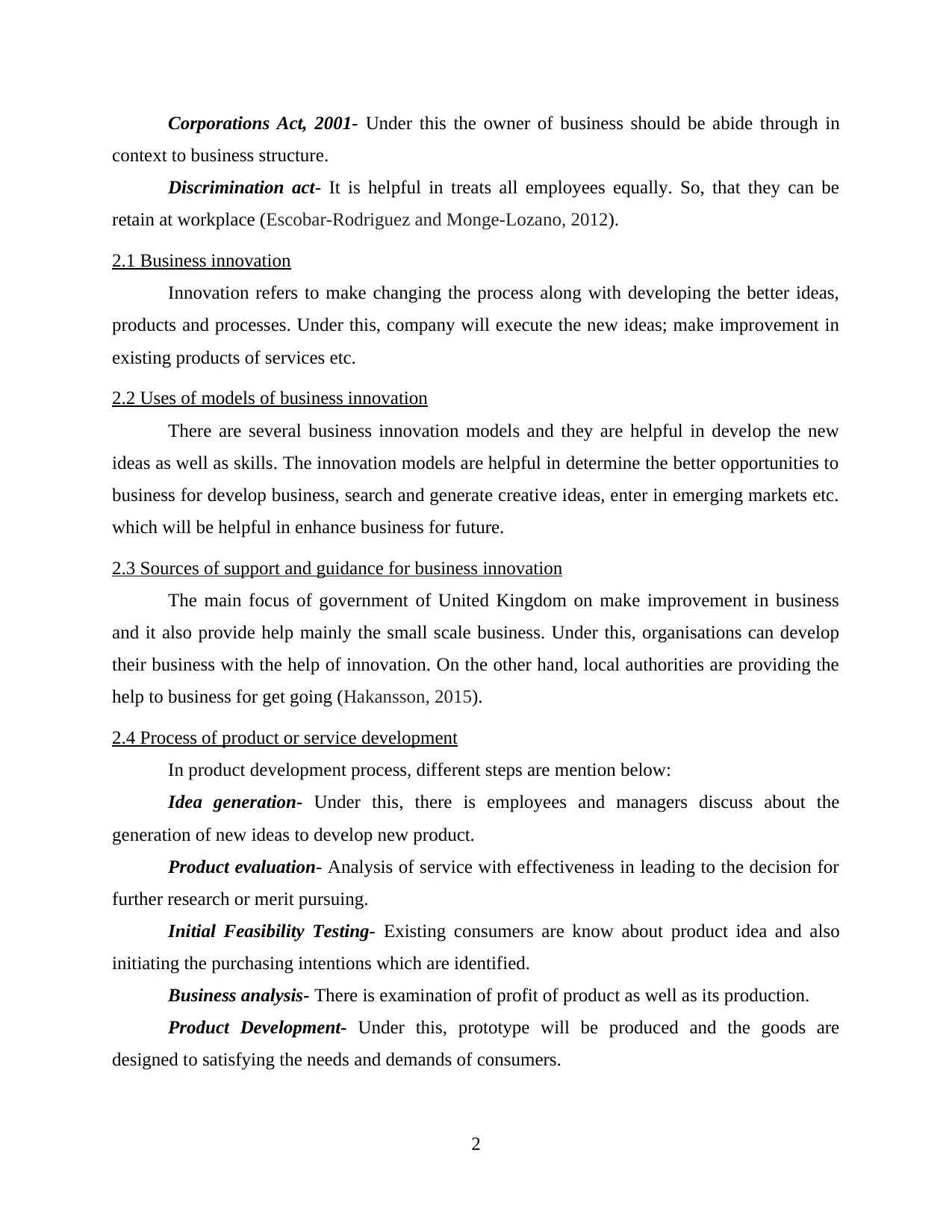
Corporations Act, 2001- Under this the owner of business should be abide through in
context to business structure.
Discrimination act- It is helpful in treats all employees equally. So, that they can be
retain at workplace (Escobar-Rodriguez and Monge-Lozano, 2012).
2.1 Business innovation
Innovation refers to make changing the process along with developing the better ideas,
products and processes. Under this, company will execute the new ideas; make improvement in
existing products of services etc.
2.2 Uses of models of business innovation
There are several business innovation models and they are helpful in develop the new
ideas as well as skills. The innovation models are helpful in determine the better opportunities to
business for develop business, search and generate creative ideas, enter in emerging markets etc.
which will be helpful in enhance business for future.
2.3 Sources of support and guidance for business innovation
The main focus of government of United Kingdom on make improvement in business
and it also provide help mainly the small scale business. Under this, organisations can develop
their business with the help of innovation. On the other hand, local authorities are providing the
help to business for get going (Hakansson, 2015).
2.4 Process of product or service development
In product development process, different steps are mention below:
Idea generation- Under this, there is employees and managers discuss about the
generation of new ideas to develop new product.
Product evaluation- Analysis of service with effectiveness in leading to the decision for
further research or merit pursuing.
Initial Feasibility Testing- Existing consumers are know about product idea and also
initiating the purchasing intentions which are identified.
Business analysis- There is examination of profit of product as well as its production.
Product Development- Under this, prototype will be produced and the goods are
designed to satisfying the needs and demands of consumers.
2
context to business structure.
Discrimination act- It is helpful in treats all employees equally. So, that they can be
retain at workplace (Escobar-Rodriguez and Monge-Lozano, 2012).
2.1 Business innovation
Innovation refers to make changing the process along with developing the better ideas,
products and processes. Under this, company will execute the new ideas; make improvement in
existing products of services etc.
2.2 Uses of models of business innovation
There are several business innovation models and they are helpful in develop the new
ideas as well as skills. The innovation models are helpful in determine the better opportunities to
business for develop business, search and generate creative ideas, enter in emerging markets etc.
which will be helpful in enhance business for future.
2.3 Sources of support and guidance for business innovation
The main focus of government of United Kingdom on make improvement in business
and it also provide help mainly the small scale business. Under this, organisations can develop
their business with the help of innovation. On the other hand, local authorities are providing the
help to business for get going (Hakansson, 2015).
2.4 Process of product or service development
In product development process, different steps are mention below:
Idea generation- Under this, there is employees and managers discuss about the
generation of new ideas to develop new product.
Product evaluation- Analysis of service with effectiveness in leading to the decision for
further research or merit pursuing.
Initial Feasibility Testing- Existing consumers are know about product idea and also
initiating the purchasing intentions which are identified.
Business analysis- There is examination of profit of product as well as its production.
Product Development- Under this, prototype will be produced and the goods are
designed to satisfying the needs and demands of consumers.
2
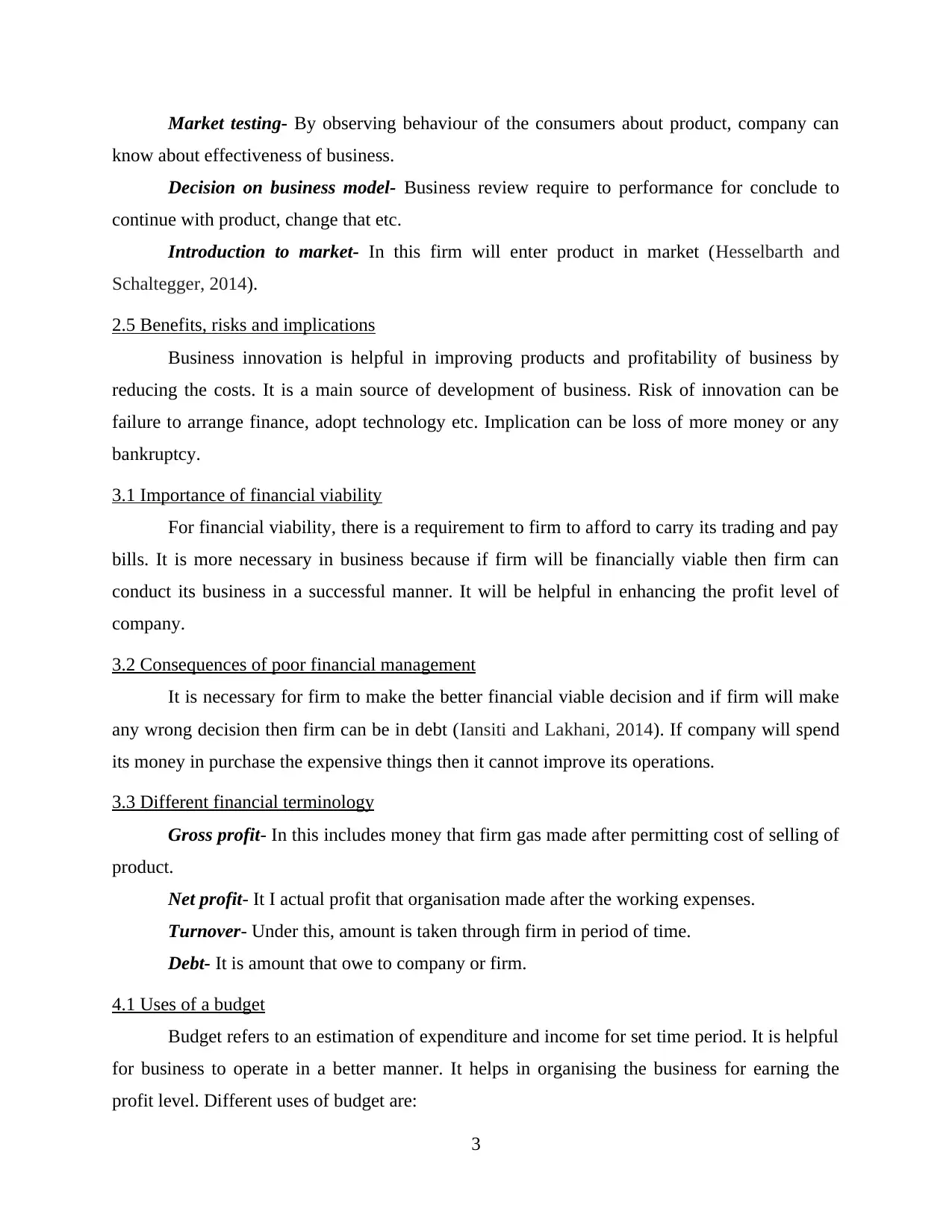
Market testing- By observing behaviour of the consumers about product, company can
know about effectiveness of business.
Decision on business model- Business review require to performance for conclude to
continue with product, change that etc.
Introduction to market- In this firm will enter product in market (Hesselbarth and
Schaltegger, 2014).
2.5 Benefits, risks and implications
Business innovation is helpful in improving products and profitability of business by
reducing the costs. It is a main source of development of business. Risk of innovation can be
failure to arrange finance, adopt technology etc. Implication can be loss of more money or any
bankruptcy.
3.1 Importance of financial viability
For financial viability, there is a requirement to firm to afford to carry its trading and pay
bills. It is more necessary in business because if firm will be financially viable then firm can
conduct its business in a successful manner. It will be helpful in enhancing the profit level of
company.
3.2 Consequences of poor financial management
It is necessary for firm to make the better financial viable decision and if firm will make
any wrong decision then firm can be in debt (Iansiti and Lakhani, 2014). If company will spend
its money in purchase the expensive things then it cannot improve its operations.
3.3 Different financial terminology
Gross profit- In this includes money that firm gas made after permitting cost of selling of
product.
Net profit- It I actual profit that organisation made after the working expenses.
Turnover- Under this, amount is taken through firm in period of time.
Debt- It is amount that owe to company or firm.
4.1 Uses of a budget
Budget refers to an estimation of expenditure and income for set time period. It is helpful
for business to operate in a better manner. It helps in organising the business for earning the
profit level. Different uses of budget are:
3
know about effectiveness of business.
Decision on business model- Business review require to performance for conclude to
continue with product, change that etc.
Introduction to market- In this firm will enter product in market (Hesselbarth and
Schaltegger, 2014).
2.5 Benefits, risks and implications
Business innovation is helpful in improving products and profitability of business by
reducing the costs. It is a main source of development of business. Risk of innovation can be
failure to arrange finance, adopt technology etc. Implication can be loss of more money or any
bankruptcy.
3.1 Importance of financial viability
For financial viability, there is a requirement to firm to afford to carry its trading and pay
bills. It is more necessary in business because if firm will be financially viable then firm can
conduct its business in a successful manner. It will be helpful in enhancing the profit level of
company.
3.2 Consequences of poor financial management
It is necessary for firm to make the better financial viable decision and if firm will make
any wrong decision then firm can be in debt (Iansiti and Lakhani, 2014). If company will spend
its money in purchase the expensive things then it cannot improve its operations.
3.3 Different financial terminology
Gross profit- In this includes money that firm gas made after permitting cost of selling of
product.
Net profit- It I actual profit that organisation made after the working expenses.
Turnover- Under this, amount is taken through firm in period of time.
Debt- It is amount that owe to company or firm.
4.1 Uses of a budget
Budget refers to an estimation of expenditure and income for set time period. It is helpful
for business to operate in a better manner. It helps in organising the business for earning the
profit level. Different uses of budget are:
3
⊘ This is a preview!⊘
Do you want full access?
Subscribe today to unlock all pages.

Trusted by 1+ million students worldwide
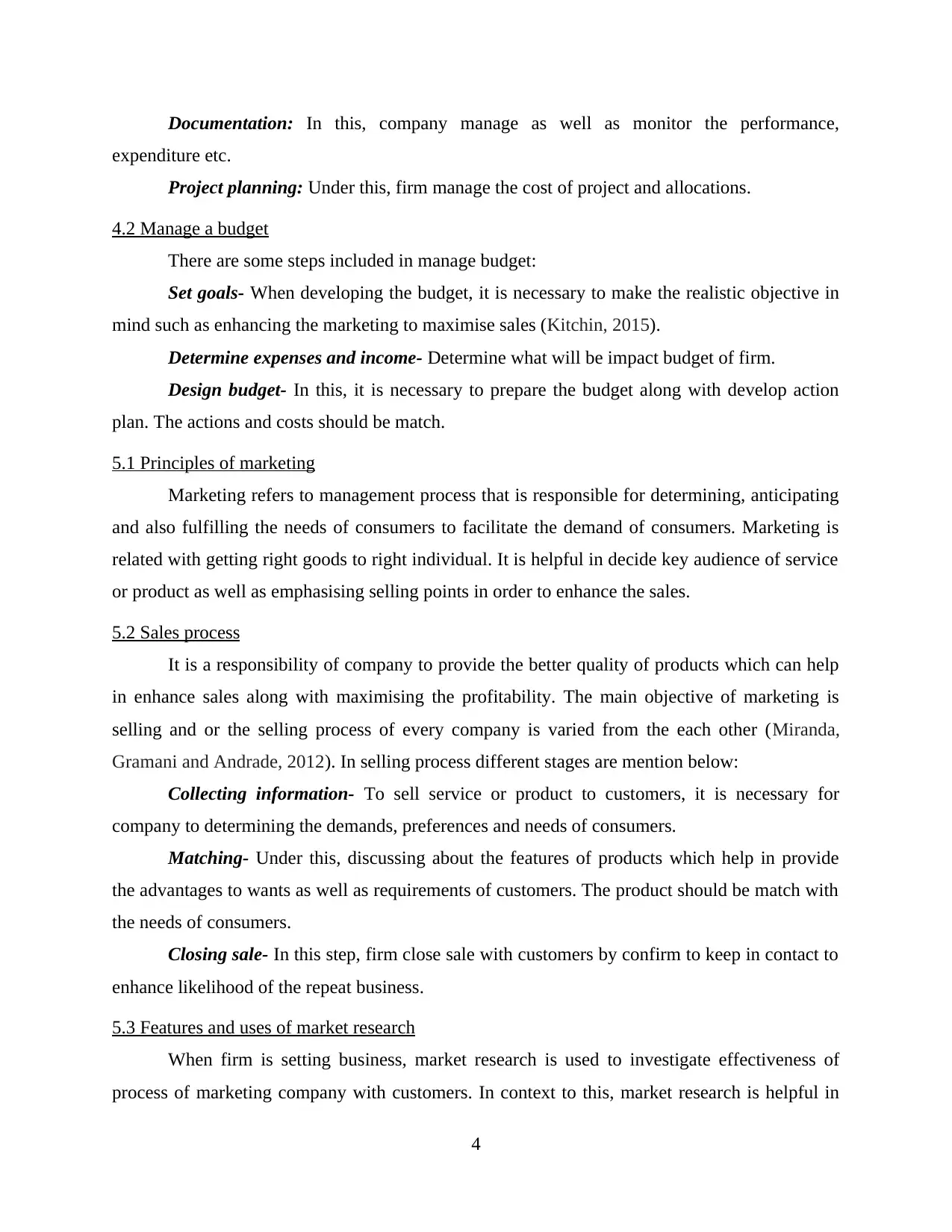
Documentation: In this, company manage as well as monitor the performance,
expenditure etc.
Project planning: Under this, firm manage the cost of project and allocations.
4.2 Manage a budget
There are some steps included in manage budget:
Set goals- When developing the budget, it is necessary to make the realistic objective in
mind such as enhancing the marketing to maximise sales (Kitchin, 2015).
Determine expenses and income- Determine what will be impact budget of firm.
Design budget- In this, it is necessary to prepare the budget along with develop action
plan. The actions and costs should be match.
5.1 Principles of marketing
Marketing refers to management process that is responsible for determining, anticipating
and also fulfilling the needs of consumers to facilitate the demand of consumers. Marketing is
related with getting right goods to right individual. It is helpful in decide key audience of service
or product as well as emphasising selling points in order to enhance the sales.
5.2 Sales process
It is a responsibility of company to provide the better quality of products which can help
in enhance sales along with maximising the profitability. The main objective of marketing is
selling and or the selling process of every company is varied from the each other (Miranda,
Gramani and Andrade, 2012). In selling process different stages are mention below:
Collecting information- To sell service or product to customers, it is necessary for
company to determining the demands, preferences and needs of consumers.
Matching- Under this, discussing about the features of products which help in provide
the advantages to wants as well as requirements of customers. The product should be match with
the needs of consumers.
Closing sale- In this step, firm close sale with customers by confirm to keep in contact to
enhance likelihood of the repeat business.
5.3 Features and uses of market research
When firm is setting business, market research is used to investigate effectiveness of
process of marketing company with customers. In context to this, market research is helpful in
4
expenditure etc.
Project planning: Under this, firm manage the cost of project and allocations.
4.2 Manage a budget
There are some steps included in manage budget:
Set goals- When developing the budget, it is necessary to make the realistic objective in
mind such as enhancing the marketing to maximise sales (Kitchin, 2015).
Determine expenses and income- Determine what will be impact budget of firm.
Design budget- In this, it is necessary to prepare the budget along with develop action
plan. The actions and costs should be match.
5.1 Principles of marketing
Marketing refers to management process that is responsible for determining, anticipating
and also fulfilling the needs of consumers to facilitate the demand of consumers. Marketing is
related with getting right goods to right individual. It is helpful in decide key audience of service
or product as well as emphasising selling points in order to enhance the sales.
5.2 Sales process
It is a responsibility of company to provide the better quality of products which can help
in enhance sales along with maximising the profitability. The main objective of marketing is
selling and or the selling process of every company is varied from the each other (Miranda,
Gramani and Andrade, 2012). In selling process different stages are mention below:
Collecting information- To sell service or product to customers, it is necessary for
company to determining the demands, preferences and needs of consumers.
Matching- Under this, discussing about the features of products which help in provide
the advantages to wants as well as requirements of customers. The product should be match with
the needs of consumers.
Closing sale- In this step, firm close sale with customers by confirm to keep in contact to
enhance likelihood of the repeat business.
5.3 Features and uses of market research
When firm is setting business, market research is used to investigate effectiveness of
process of marketing company with customers. In context to this, market research is helpful in
4
Paraphrase This Document
Need a fresh take? Get an instant paraphrase of this document with our AI Paraphraser
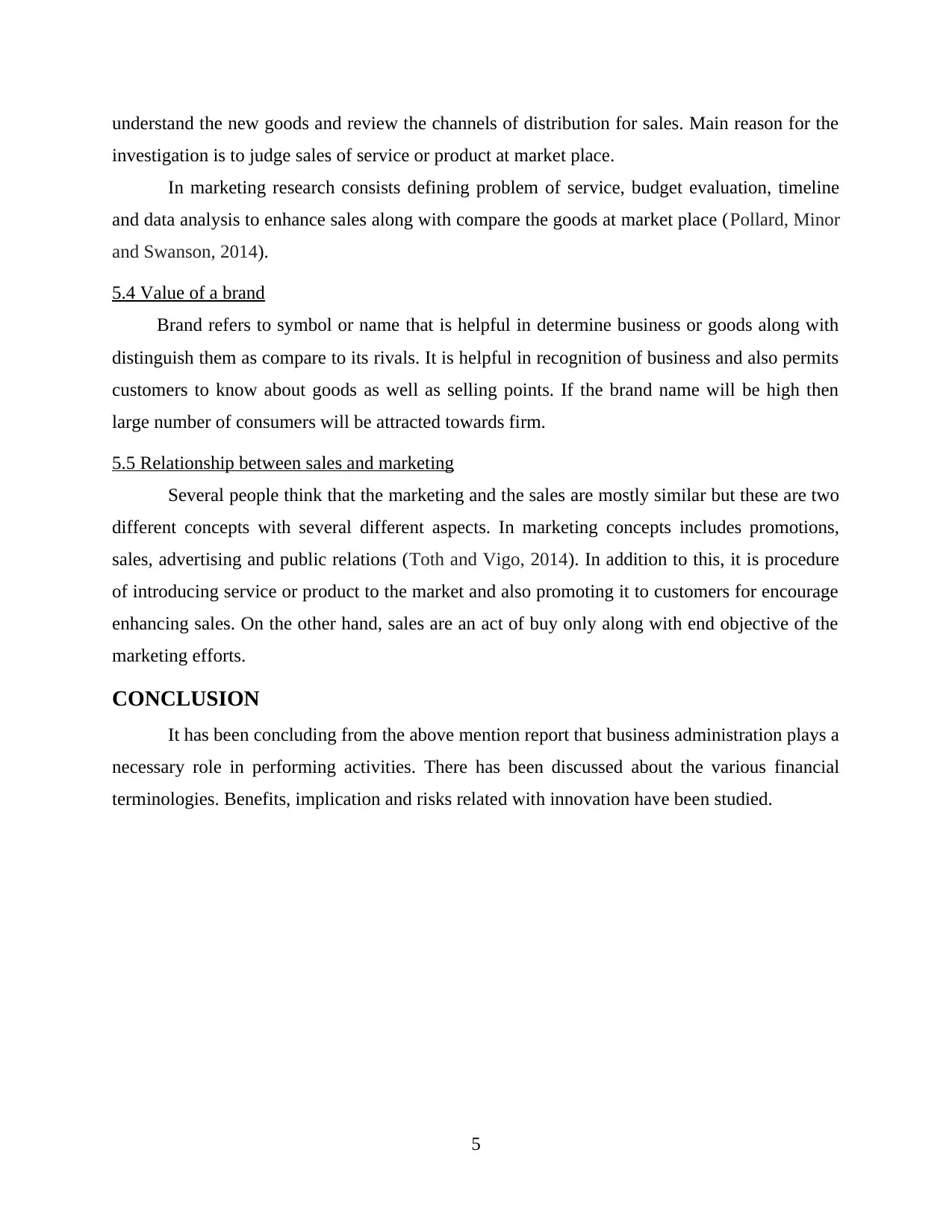
understand the new goods and review the channels of distribution for sales. Main reason for the
investigation is to judge sales of service or product at market place.
In marketing research consists defining problem of service, budget evaluation, timeline
and data analysis to enhance sales along with compare the goods at market place (Pollard, Minor
and Swanson, 2014).
5.4 Value of a brand
Brand refers to symbol or name that is helpful in determine business or goods along with
distinguish them as compare to its rivals. It is helpful in recognition of business and also permits
customers to know about goods as well as selling points. If the brand name will be high then
large number of consumers will be attracted towards firm.
5.5 Relationship between sales and marketing
Several people think that the marketing and the sales are mostly similar but these are two
different concepts with several different aspects. In marketing concepts includes promotions,
sales, advertising and public relations (Toth and Vigo, 2014). In addition to this, it is procedure
of introducing service or product to the market and also promoting it to customers for encourage
enhancing sales. On the other hand, sales are an act of buy only along with end objective of the
marketing efforts.
CONCLUSION
It has been concluding from the above mention report that business administration plays a
necessary role in performing activities. There has been discussed about the various financial
terminologies. Benefits, implication and risks related with innovation have been studied.
5
investigation is to judge sales of service or product at market place.
In marketing research consists defining problem of service, budget evaluation, timeline
and data analysis to enhance sales along with compare the goods at market place (Pollard, Minor
and Swanson, 2014).
5.4 Value of a brand
Brand refers to symbol or name that is helpful in determine business or goods along with
distinguish them as compare to its rivals. It is helpful in recognition of business and also permits
customers to know about goods as well as selling points. If the brand name will be high then
large number of consumers will be attracted towards firm.
5.5 Relationship between sales and marketing
Several people think that the marketing and the sales are mostly similar but these are two
different concepts with several different aspects. In marketing concepts includes promotions,
sales, advertising and public relations (Toth and Vigo, 2014). In addition to this, it is procedure
of introducing service or product to the market and also promoting it to customers for encourage
enhancing sales. On the other hand, sales are an act of buy only along with end objective of the
marketing efforts.
CONCLUSION
It has been concluding from the above mention report that business administration plays a
necessary role in performing activities. There has been discussed about the various financial
terminologies. Benefits, implication and risks related with innovation have been studied.
5
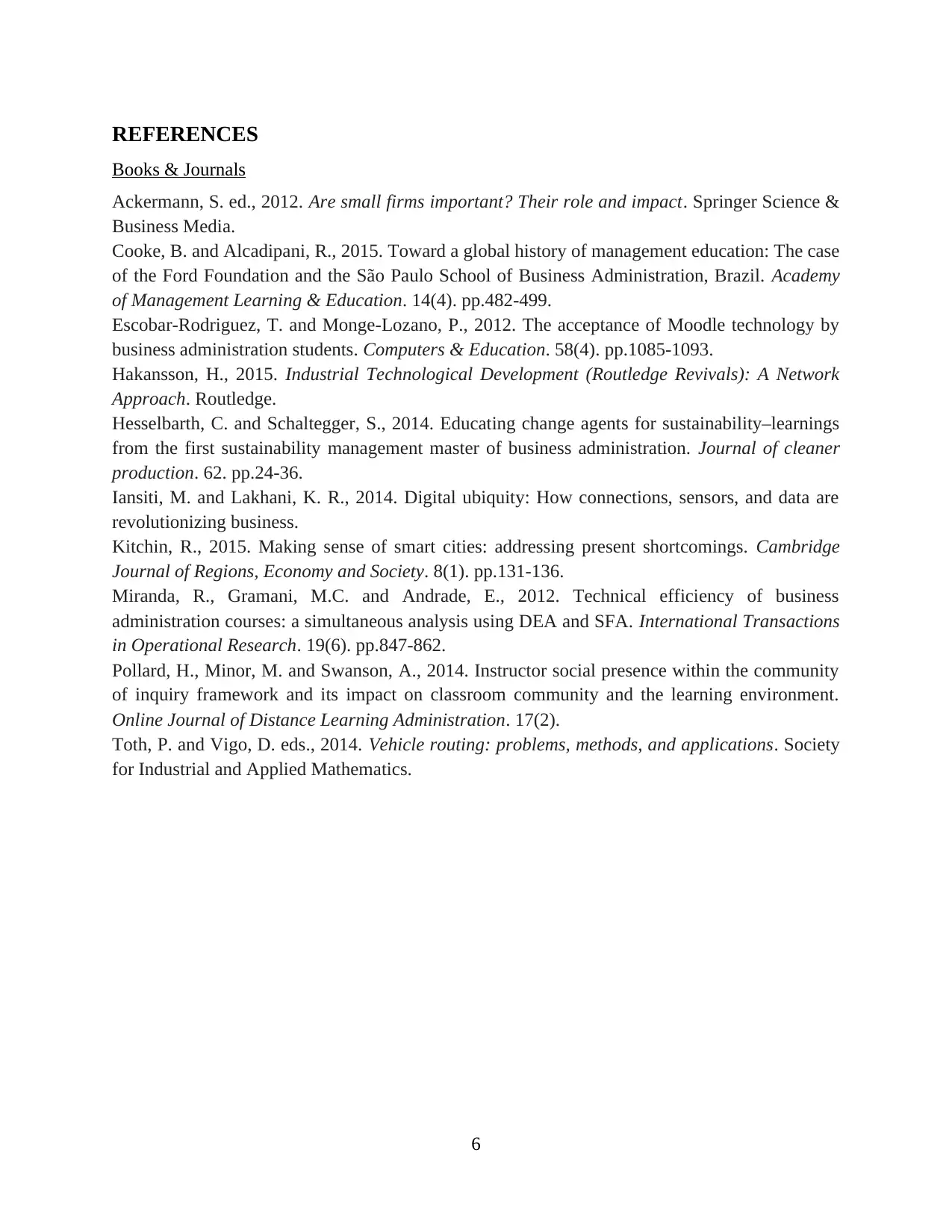
REFERENCES
Books & Journals
Ackermann, S. ed., 2012. Are small firms important? Their role and impact. Springer Science &
Business Media.
Cooke, B. and Alcadipani, R., 2015. Toward a global history of management education: The case
of the Ford Foundation and the São Paulo School of Business Administration, Brazil. Academy
of Management Learning & Education. 14(4). pp.482-499.
Escobar-Rodriguez, T. and Monge-Lozano, P., 2012. The acceptance of Moodle technology by
business administration students. Computers & Education. 58(4). pp.1085-1093.
Hakansson, H., 2015. Industrial Technological Development (Routledge Revivals): A Network
Approach. Routledge.
Hesselbarth, C. and Schaltegger, S., 2014. Educating change agents for sustainability–learnings
from the first sustainability management master of business administration. Journal of cleaner
production. 62. pp.24-36.
Iansiti, M. and Lakhani, K. R., 2014. Digital ubiquity: How connections, sensors, and data are
revolutionizing business.
Kitchin, R., 2015. Making sense of smart cities: addressing present shortcomings. Cambridge
Journal of Regions, Economy and Society. 8(1). pp.131-136.
Miranda, R., Gramani, M.C. and Andrade, E., 2012. Technical efficiency of business
administration courses: a simultaneous analysis using DEA and SFA. International Transactions
in Operational Research. 19(6). pp.847-862.
Pollard, H., Minor, M. and Swanson, A., 2014. Instructor social presence within the community
of inquiry framework and its impact on classroom community and the learning environment.
Online Journal of Distance Learning Administration. 17(2).
Toth, P. and Vigo, D. eds., 2014. Vehicle routing: problems, methods, and applications. Society
for Industrial and Applied Mathematics.
6
Books & Journals
Ackermann, S. ed., 2012. Are small firms important? Their role and impact. Springer Science &
Business Media.
Cooke, B. and Alcadipani, R., 2015. Toward a global history of management education: The case
of the Ford Foundation and the São Paulo School of Business Administration, Brazil. Academy
of Management Learning & Education. 14(4). pp.482-499.
Escobar-Rodriguez, T. and Monge-Lozano, P., 2012. The acceptance of Moodle technology by
business administration students. Computers & Education. 58(4). pp.1085-1093.
Hakansson, H., 2015. Industrial Technological Development (Routledge Revivals): A Network
Approach. Routledge.
Hesselbarth, C. and Schaltegger, S., 2014. Educating change agents for sustainability–learnings
from the first sustainability management master of business administration. Journal of cleaner
production. 62. pp.24-36.
Iansiti, M. and Lakhani, K. R., 2014. Digital ubiquity: How connections, sensors, and data are
revolutionizing business.
Kitchin, R., 2015. Making sense of smart cities: addressing present shortcomings. Cambridge
Journal of Regions, Economy and Society. 8(1). pp.131-136.
Miranda, R., Gramani, M.C. and Andrade, E., 2012. Technical efficiency of business
administration courses: a simultaneous analysis using DEA and SFA. International Transactions
in Operational Research. 19(6). pp.847-862.
Pollard, H., Minor, M. and Swanson, A., 2014. Instructor social presence within the community
of inquiry framework and its impact on classroom community and the learning environment.
Online Journal of Distance Learning Administration. 17(2).
Toth, P. and Vigo, D. eds., 2014. Vehicle routing: problems, methods, and applications. Society
for Industrial and Applied Mathematics.
6
⊘ This is a preview!⊘
Do you want full access?
Subscribe today to unlock all pages.

Trusted by 1+ million students worldwide
1 out of 9
Related Documents
Your All-in-One AI-Powered Toolkit for Academic Success.
+13062052269
info@desklib.com
Available 24*7 on WhatsApp / Email
![[object Object]](/_next/static/media/star-bottom.7253800d.svg)
Unlock your academic potential
Copyright © 2020–2025 A2Z Services. All Rights Reserved. Developed and managed by ZUCOL.





